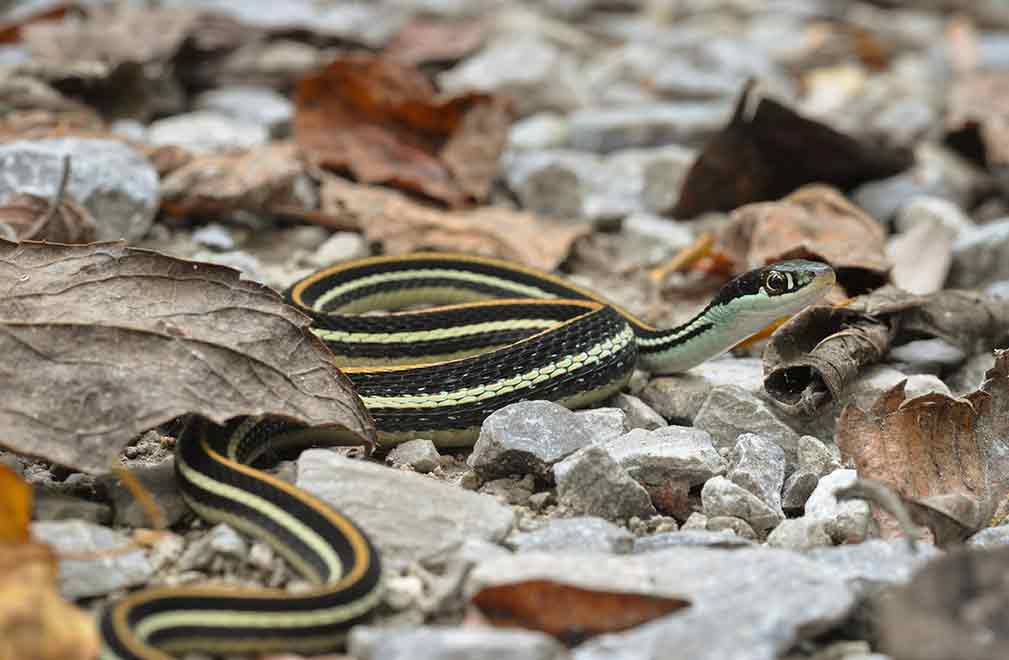The U.S. Forest Service usually closes the 2.5 mile road March 15, but due to warming weather, the road closed March 5.
Snake Road in Illinois’ Shawnee National Forest closed March 5 for the annual migration of reptiles and amphibians to their spring habitats from the limestone bluffs in which they wintered. The U.S. Forest Service usually closes the 2.5 mile road March 15, but due to warming weather, the road closed March 5.
LaRue Road and Forest Service Road No. 345 also known as “Snake Road” will be closed to vehicle traffic for about two months to allow these herps, some that are listed as threatened and endangered in the state and the country, to safely cross the road. The road in 1991 became the country’s 250th Research Natural Area (RNA), an area that is permanently protected to maintain the biological diversity as well as give researchers the capability to monitor undisturbed areas.
The road will remain open to people on foot, so if you are near the area, it would be an opportune time to see a lot of reptiles and amphibians in a single location, and especially on the 2.5 mile road.
9 Days On Shawnee National Forest’s Snake Road Of Illinois
The road is found on federal lands and specific rules apply year round on Snake Road as well as the research natural area:
• No collecting or handling of any animal or plant species is permitted unless authorized
• No tongs, snake hooks, bags or containers of any type are permitted
• All trash must be packed out
• Must stay on the Snake Road. Cannot go off the road or any trails
• No damage to vegetation is allowed. No picking of wildflowers is permitted
• No moving of rocks or logs is permitted
• Harassing or otherwise disturbing wildlife is prohibited
The state is home to 35 snake species, including water moccasins, southern copperhead, blue racer, northern scarlet snake, northern and prairie ring-necked snake, and southern black racers, just to name a few. The LaRue-Pine Hills/Otter Pond Research Natural Area features more than 1200 plant and animal species, many of which are threatened or endangered. The forest service says that about 66 percent of amphibians and 59 percent of the reptiles that can be found in Illinois occur in the RNA.
The road closure is ideal for those who love to watch birds, see native plants and observe insects as well. For more information on Snake Road and the migration, visit the Shawnee National Park website.
Common names of some of the species you might encounter on or near Snake Road include:
Spiny Softshell
Northern Red-Bellied Snake
Spotted Salamander
Chorus Frog
Slimy Salamander
Broadheaded Skink
Eastern Hognose Snake
Red Milk Snake
Midland Water Snake
Western Ribbon Snake
Eastern Rough Green Snake
Eastern Garter Snake
Western Lesser Siren
Marbled Salamander
Small-Mouthed Salamander
Midwest Worm Snake
Central Newt
Zigzag salamander
Long-Tailed Salamander
Black Rat Snake
Cave Salamander
American Toad
Fowler’s Toad
Copperhead
Blanchard’s Cricket Frog
Northern Spring Peeper
Eastern Grey Treefrog
Black Racer
Bullfrog
Green Frog
Southern Leopard Frog
Midland Brown Snake
Common Snapping Turtle
Stinkpot Turtle
Eastern Box Turtle
Ringneck Snake
Eastern Painted Turtle
Red-Eared Turtle
Northern Fence Lizard
King Snake
Ground Skink
Western Cotton Mouth
Five-Lined Skink
Western Earth Snake
Western Mud Snake
Diamond-Backed Water Snake



